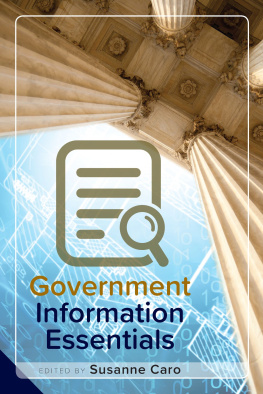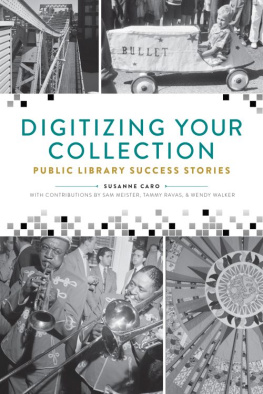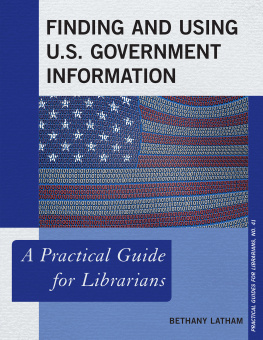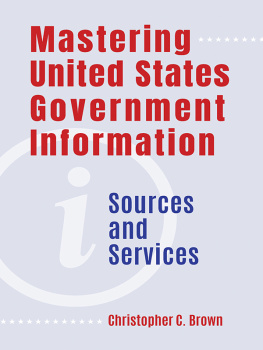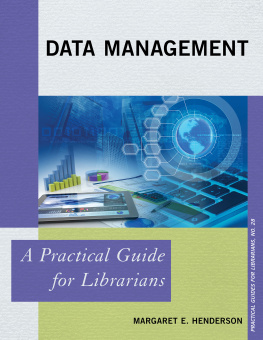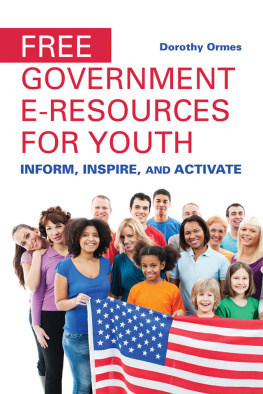
ALA Editions purchases fund advocacy, awareness, and accreditation programs for library professionals worldwide.

SUSANNE CARO has ten years of experience working with all levels of government information. She is the Federal Depository Library Program regional coordinator for Montana and is the government information librarian at the University of Montana in Missoula. Previously she was the state document librarian and coordinator of the New Mexico State Depository Program. She is the author of Digitizing Your Collection: Public Library Success Stories (2015).
2018 by the American Library Association
Extensive effort has gone into ensuring the reliability of the information in this book; however, the publisher makes no warranty, express or implied, with respect to the material contained herein.
ISBNs
978-0-8389-1597-4 (paper)
978-0-8389-1607-0 (PDF)
978-0-8389-1608-7 (ePub)
978-0-8389-1609-4 (Kindle)
Library of Congress Cataloging-in-Publication Data
Names: Caro, Susanne, 1980- editor.
Title: Government information essentials / edited by Susanne Caro.
Description: Chicago : ALA Editions, an imprint of the American Library Association, 2018. | Includes bibliographical references and .
Identifiers: LCCN 2017024225| ISBN 9780838915974 (pbk. : alk. paper) | ISBN 9780838916070 (pdf) | ISBN 9780838916087 (epub) | ISBN 9780838916094 (Kindle)
Subjects: LCSH: Documents librariesUnited StatesAdministration. | LibrariesUnited StatesSpecial collectionsGovernment publications. | Government publicationsUnited StatesHandbooks, manuals, etc. | Depository librariesUnited StatesAdministration. | Documents librariansUnited States. | Federal Depository Library Program.
Classification: LCC Z675.D63 G65 2018 | DDC 025.2/8340973dc23 LC record available at https://lccn.loc.gov/2017024225.
Cover images Adobe Stock.
Contents
Government Documents and the People Who Use Them
SUSANNE CARO
PART I
ADVICE FOR THE NEW DOCUMENT PROFESSIONAL
HAYLEY JOHNSON
ANDREW LOPEZ AND LORI LOONEY
JILL VASSILAKOS-LONG
PART II
COLLECTION MANAGEMENT
AIME C. QUINN
JULIA STEWART
VICKIE MIX
SUSANNE CARO
PART III
WORKING WITH COLLECTIONS
PAULA L. WEBB AND LEASHA E. MARTIN
VALERY KING
JANE CANFIELD
PART IV
TEACHING AND TRAINING
LATANYA N. JENKINS
DAVID DILLARD
SUSANNE CARO
ANTOINETTE W. SATTERFIELD
PART V
ADVOCACY AND EVENTS
SHARI LASTER
LISA PRITCHARD
SUSANNE CARO
APPENDIXES
SUSANNE CARO
Government Documents and the People Who Use Them
GOVERNMENT DOCUMENTS, physical and electronic, ARE a rich and varied resource. The libraries that house these materials and the people who work with them are equally diverse, including public, special, academic, tribal, and federal libraries. These libraries may be associated with the Federal Depository Library Program (FDLP), a state depository program, or a special collection, or they may offer access to government information because their users need those resources.
Although government information is useful and pervasive in libraries, not everyone who works with these materials has received in-depth training on the collections. Many librarians who count government resources among their job duties find themselves in these positions by accident. They may have little or no experience when they start, and this lack has been addressed, to an extent, through online webinars produced by state and federal organizations. One important resource for both new and experienced library professionals is their colleagues from around the country and the world. Through meetings at conferences and electronic discussion lists, those working with government information can seek advice from others who have had similar challenges and experiences.
This book attempts to capture the expertise of experienced government information librarians and address many issues that are not dealt with in other sources. The perspectives of those who work with these special collections provide real-world insight into the work, collections, and interests of the profession.
WHAT IS GOVERNMENT INFORMATION?
Government information is any material created by local, state, federal, or international governments and governmental agencies or by intergovernmental organizations. Government information increasingly is being produced in electronic formats and encompasses databases, geographic information systems (GIS), Twitter feeds, and Instagram posts. This move toward electronically published resources provides greater access while costing the issuing agency less to produce. A result of this trend is that any library can provide government-issued information.
Levels of Government Information
All levels of government produce materials intended for public consumption. These items make up the majority of government material found in libraries whereas internal documents, policies, handbooks, and confidential information are rarely disseminated. These internal documents can find their way to libraries or may be accessed through a Freedom of Information Act (FOIA) request.
Local and State Information
Local documents generally consist of city council and agency minutes, public notices, land records, ordinances, and health reports. If a city library has an archive, it might house other materials recording the actions and administration of the community and county. Local public libraries or county courthouses and clerks offices are most likely to house these resources.
State-level documents are broader and can contain city- and county-level data, but the information tends to be less specific. For example, a county-level report lists each town and city within the countys boundaries, whereas a state-level report condenses that information to the county level only. High-interest materials are state budgets, legislative bills, and information related to public programs, such as health insurance and social support. The tangible materials range from wall calendars to multivolume books of state laws.
Many states, including Alaska, Florida, New Mexico, and Washington, have depository systems to disseminate information. These systems are frequently statutory in nature and are intended to provide the public with access to state materials. Some states have significantly reduced or eliminated print publications unless requested, resulting in changes to how depositories are managed.
Federal and International Information
Federal documents are the most varied and numerous. More than one thousand libraries in the United States obtain federal materials through the FDLP, which is part of the Government Publishing Office (GPO). If your library is not part of this program, you may still get federal materials through the database govinfo.gov or specific agencies such as the Internal Revenue Service (IRS), the National Institutes of Health, the Department of Veterans Affairs, or the Department of State. Federal documents include legislative bills, budgets, notices, reports, and recommendations. Most federal agencies publish their content online but still issue some materials in print.
Intergovernmental organizations (IGOs) or government-related organizations (GROs) are independent, nonprofit organizations with representatives from different countries. These organizations receive funding and support from multiple countries. IGOs such as the United Nations (UN), the World Health Organization (WHO) which is part of the UN, and the World Bank are made up of representatives of different countries. These groups produce resources that provide a global perspective and often compile government information from different countries, creating a picture of conditions and issues around the world. The UN has a depository program, but that program is changing and may disappear in favor of a paid database.
Next page
